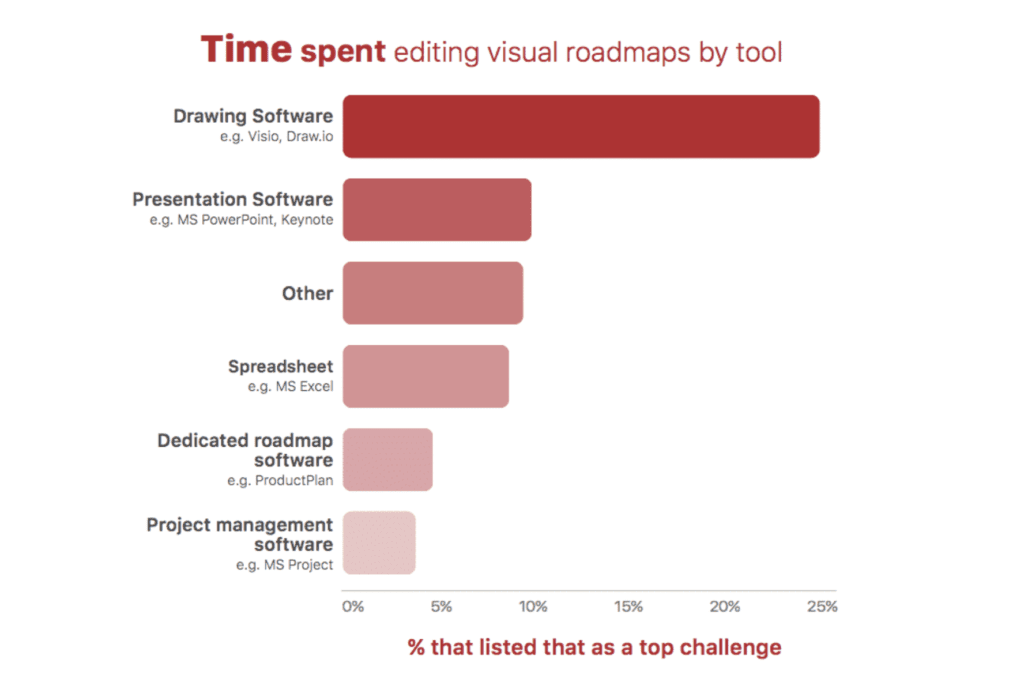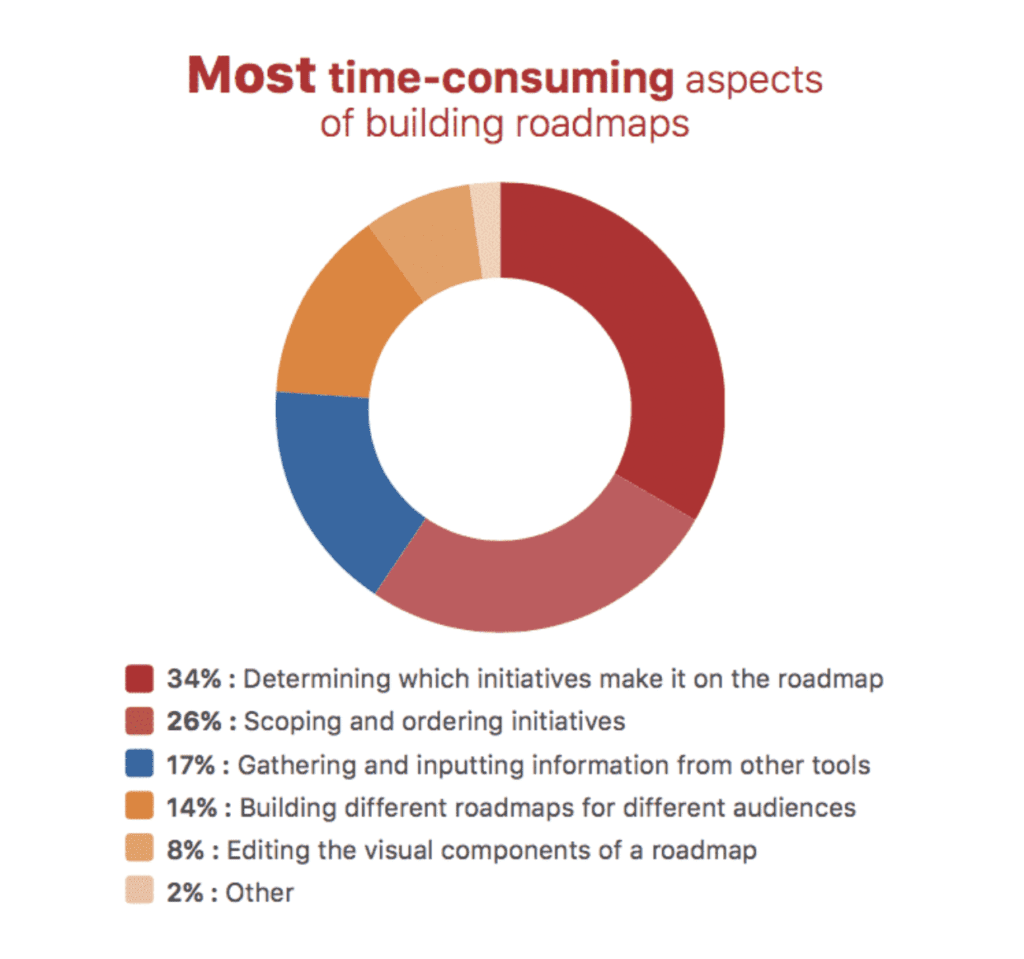A successful product roadmap is, in a sense, a work of art. So to answer the question and understand the roadmap creation process, “How long should creating a roadmap take?” let’s start with an anecdote about Pablo Picasso.
When a woman recognized Picasso in the park, she rushed over to him and begged him to sketch her portrait.
Picasso agreed, and the artist flipped his notebook open to a fresh piece of paper. A couple of minutes later, he tore off the sheet and showed it to the woman.
She was overjoyed and told the artist that he’d depicted her essence perfectly. But when Picasso told her the price—$5,000—the woman became confused. “How could you charge that much?” she asked. “It took you one minute.”
“No,” Picasso said. “It took me my whole life.”
Similarly, creating a product roadmap requires a lot more than just the time it takes you to literally document all of the necessary details and plans you have for your product. Let’s look at what you’ll need before you begin sketching out your roadmap. Then we’ll discuss the three possible answers to the question of how long it should take to create your roadmap.
What Is the Purpose of a Roadmap?
Before diving into actually creating a roadmap, you should know why you’re doing this in the first place. Roadmaps serve a critical function in any product development setting. The tool builds consensus, ensures stakeholder alignment, and provides a shared view of where the product is heading.
Different styles of roadmap provide varying levels of detail on both the timing and contents of upcoming releases. Whether it’s a date-laden “feature fest” or a theme-based visual roadmap, they all serve as inspiration for teams.
Roadmaps also facilitate strategic planning at every level. Knowing what’s coming down the pike enables managers to allocate resources accordingly and do advanced research to better scope and staff for future projects. Roadmaps provide direction for planning events and campaigns and priming prospects for the exciting things to come for sales and marketing. And for executives, the board, and investors, roadmaps visualize how the business will reach its strategic goals and objectives.
Also, don’t ever let anyone tell you the product doesn’t need a roadmap. Agile benefits from product roadmaps and roadmap creation in SAFe is a critical part of the process. No matter how fast you sprint, you still need to know where you’re going.
5 Elements Your Roadmap Should Include?
If it seems like roadmaps serve many different purposes, you’re not wrong. They’re undoubtedly the most crucial artifact the product team produces. Roadmaps should include the following elements.
1. Themes
Rather than planning every feature or enhancement that the team will build for the next year, the best roadmaps instead utilize themes. Each represents an area of strategic focus or a specific goal or objective for the product. The individual features, enhancements, updates, and improvements of a given theme aren’t exposed at the top level, giving the team more latitude and flexibility to maximize the development window and deliver the items with the most value and best ROI.
2. Timeline
While specific dates may or may not have a place in your roadmap, you need some timeline to indicate roughly when different initiatives get implemented. Quarter-based segmentation is usually sufficient, with anything more specific relegated to more detailed project plans for each project.
3. Milestones
Some dates can’t change, so if these exist, they should include as well. These might consist of specific customer commitments, conferences, press events, or marketing activities that can’t budge and are a challenging target for a particular release.
4. Color-coding
Color-coding the roadmap provides a quick visual cue to the audience with a relatively limited set of visual elements to incorporate. You can tie this color-coding to which team is building it, which strategic goal it advances, or what part of the product/business it’s part of. Whatever helps tell the story as quickly and clearly as possible.
5. Swimlanes
Plotting out upcoming items in different tracks can communicate how to accomplish the work or what part of the product it applies to (for example, having one swimlane for the back-end, one for the website, and another for the mobile app). Swimlanes provide additional clarity and make the roadmap seem less monolithic by emphasizing what’s happening in parallel.
What Is a Roadmap Strategy?
Your roadmap strategy isn’t your product strategy. It’s how you’re going to go about actually creating your roadmap. Since you don’t just sit down one afternoon and crank one out, you must plan out the steps to create a roadmap aligned with the needs and concerns of key stakeholders and includes them appropriately in the roadmap creation process.
It would help if you always began by confirming any assumptions and ensuring the vision and strategy for the product are agreed upon and in place. Next comes a round of socialization with critical stakeholders, making sure you’re aware of their current mindsets and concerns.
Prioritization exercises come next, with many frameworks and methodologies to choose from. These activities must include representatives from across the organization to avoid blind spots or an individual skewing the results.
Prioritization should yield a much clearer view of what the product needs to achieve its objectives. Those items can be aggregated into themes and plotted into the roadmap. Then it’s time for one more round of socialization, checking in with each stakeholder to ensure they’re primarily on board with the plan before taking it to the entire executive team for approval.
Once greenlit, you can then present the roadmap to different audiences, tailoring it appropriately to their interests and required level of detail. And, if the opportunity arises, don’t forget to squeeze a review into the next company all-hands meeting.
How Do You Create a Roadmap?
Before you can begin building a tangible product roadmap, you’ll need to have the following elements in place:
- An overall vision for your product (what you hope it will accomplish in the market)
- A high-level plan for bringing that vision to reality
- Evidence or some other type of strategic justification for each significant element of your product’s strategic plan
- A clear understanding of your audience for the roadmap (and, if you are presenting it to multiple audiences, you might need variations of the exact roadmap)

Many planning, conversations with stakeholders, and legwork go into the pre-creation stage of developing a roadmap. Also, as you can see from the graph above, creating a roadmap is an ongoing process that never truly ends as long as the organization is still improving, updating, and supporting the product. From our Product Planning Report, this graph shows product managers edit and update their roadmaps throughout their products’ lifecycles.
With all of this in mind, here are a few different ways to approach the question of how long you can expect your roadmap creation to take.
3 Answers to the Question, “How Long Should Creating a Roadmap Take?”
1. It takes your entire career.
That’s probably a frustrating answer, but it’s essential to understand this reality.
Picasso could perfectly sketch a stranger’s portrait in just one minute only because he had spent tens of thousands of hours practicing his craft.
Similarly, creating a roadmap will always represent the cumulative experience, practice, and knowledge you’ve gained as a product manager over your career.
Developing a successful roadmap is one of the most challenging aspects of a product manager’s role. You’ll need to juggle competing priorities, say no to requests from people in your organization and maybe even your customers, and figure out how to most effectively use limited time and resources to bring a successful product to market.
The good news is that you will become more skilled at doing this as you gain experience as a product manager. But what that means, of course, is that creating a roadmap to paraphrase Picasso takes your entire career.
If you’re new to product management or want a refresher on product roadmaps, check out our short guide to creating a roadmap and our post on building a roadmap from scratch.
2. It takes as long as you’ll need to plan, strategize, and earn your company’s buy-in on the roadmap.
Creating a roadmap is not just a matter of sitting down at your desk and typing out the details. After that, it’s about doing your market research, brainstorming with your teams, weighing priorities, developing a strategic plan, and checking the feasibility of that plan against the resources you’ll have. That’s the very last—and, ideally, the shortest—part of the roadmap creation process (which we’ll discuss in more detail below).
When we surveyed hundreds of product managers, we asked what aspect of creating a roadmap took these professionals the most significant amount of time.
As the graph below illustrates, the two most time-consuming elements of building a roadmap determine which initiatives (themes, epics, etc.) earn a slot on the roadmap and scoping and order those initiatives. Combined, these two aspects of creating a roadmap account for 60% of the time product managers spend developing their roadmaps.

3. It takes minutes—if you’re using the correct, purpose-built roadmap tool.
Finally, some good news!
The physical act of creating the roadmap—like Picasso sketching that woman’s portrait—should be quick and easy, assuming you’re using the right tool for the job.
As you might have seen in the bar graph above, 25% of product managers who use drawing software to tweak, edit, and update their product roadmaps list this as a top challenge.
That certainly doesn’t seem like the most effective use of a product manager’s time. Still, it makes sense when you consider drawing tools like Visio; while terrific applications, they can’t create roadmaps. Instead, they, like presentation and spreadsheet software, output static files—whereas the dynamic nature of product development requires that product roadmaps be tweaked and updated frequently.
If you’re using the right roadmap creation tool, none of those updates will constitute a top challenge for you—as they do for product managers who use drawing software. Instead, updating will take you just minutes.




